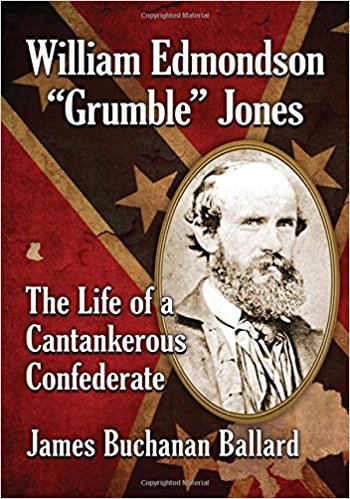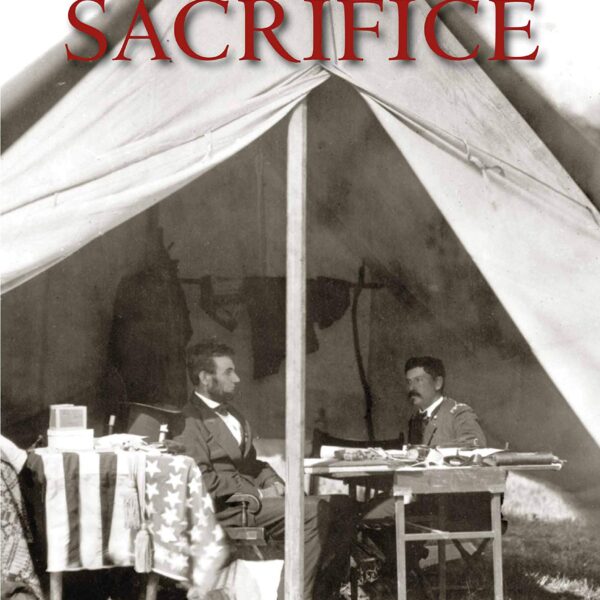William Edmondson “Grumble” Jones: The Life of a Cantankerous Confederate by James Buchanan Ballard. McFarland & Company, 2017. Paper, ISBN: 978-1476670768. $39.95.
 On June 8, 1864, three days after the Confederate defeat at the Battle of Piedmont, Virginia, the Richmond Examiner reported to its readers the “worst news of the whole affair”: Brigadier General William E. “Grumble” Jones “was certainly killed.” At the time of his death, the Examiner—and other newspapers across the Confederacy—regarded Jones as “one of the best cavalry officers in service, and [one] whom the country can ill afford to lose.” One newspaper reporter from southwestern Virginia, believing Jones’ story to be especially compelling, predicted that little time would pass before Grumble scored a biographer.
On June 8, 1864, three days after the Confederate defeat at the Battle of Piedmont, Virginia, the Richmond Examiner reported to its readers the “worst news of the whole affair”: Brigadier General William E. “Grumble” Jones “was certainly killed.” At the time of his death, the Examiner—and other newspapers across the Confederacy—regarded Jones as “one of the best cavalry officers in service, and [one] whom the country can ill afford to lose.” One newspaper reporter from southwestern Virginia, believing Jones’ story to be especially compelling, predicted that little time would pass before Grumble scored a biographer.
Despite the praise Jones received in the aftermath of his death, he has fallen into obscurity. While historians like Scott Patchan and Dobbie Edward Lambert have provided some insight into Jones through their studies of the Battle of Piedmont and the W.E. Jones Brigade, until now, “Grumble” Jones has never been the subject of a full-scale biography. James Buchanan Ballard, who specializes in the history of Washington County, Virginia, has produced a first-rate biography based on a nice array of primary source material.
In this volume’s first eight chapters, Ballard admirably chronicles Jones’ life prior to the Civil War. Whether describing Jones’ time as a student at both Emory and Henry College and West Point, his prewar military service in places such as Oregon and Texas, or his business pursuits, the author clearly illustrates that Jones confronted a great deal of obstacles and setbacks in his early life. From the tragic death of his wife while en route to a military post in Texas to the failure of the U.S. government to purchase substantial quantities of his “Jones saddle,” patented in 1854, the author lucidly contends that Jones never let any setback derail him for long.
Ballard devotes the book’s remaining thirteen chapters to Jones’ service as a Confederate cavalry officer. Jones participated in some of the war’s most significant campaigns and engagements, including First Manassas, Brandy Station, and Gettysburg. Whether examining Jones’ involvement in these iconic campaigns or his conduct at lesser-known fights such as the Battle of Rogersville (during his stint as a cavalry officer in the Department of Southwest Virginia), the author meticulously traces the movement of Jones’ command and objectively analyzes Jones’ decisions—as well as the influence he had on the Confederate war effort.
Throughout this wonderfully crafted book, the author never lapses into hagiography; he never overstates the significance of Jones’ exploits during the war. For instance, in his examination of the Jones-Imboden raid, Ballard offers an even-handed assessment. Instead of romanticizing the exploits that occurred over the raid’s approximately 700-mile course, Ballard points out that the raid really provided no significant strategic benefits to the Confederate war effort. For the Confederacy, the raid’s impact “was far more temporary and psychological” (144).
Although Ballard does a remarkable job of chronicling Grumble’s campaigns, the author never loses sight of the most significant distraction that dominated much of Jones’ Confederate service: an ongoing feud with J.E.B. Stuart. Ballard masterfully illustrates how the tension between the two commanders reached a crescendo in the wake of the Gettysburg Campaign, when Jones penned a scathing letter condemning Stuart’s conduct. Believing the letter insubordinate, Stuart ordered Jones arrested. The author does a fine job (despite a paucity of source material about the arrest and Jones’ subsequent court-martial) of reconstructing those somewhat trying months between Grumble’s arrest and his acquittal in early October 1864.
While Ballard’s analysis of Jones’ various campaigns and battles is solid, the author is perhaps at his best when examining Jones’ final fight at Piedmont. He provides not only a succinct examination of Jones’ command at this forgotten engagement in the oft-contested Shenandoah Valley, but pens a powerful description of Jones’ death and the reactions of his command to his demise.
Beyond providing an excellent biography of one of the Confederacy’s forgotten cavaliers, Ballard’s study offers other valuable nuggets that Civil War historians will find useful. For example, the author affords a compelling examination of the obstacles that confronted Confederate officers in the immediate wake of Fort Sumter, as they recruited companies and searched for suitable training grounds. Jones appealed to the board of trustees at his undergraduate alma mater, but they refused his petition. Ultimately, Jones’ resourcefulness secured space at Martha Washington College in Abingdon, Virginia.
While this biography could have benefited from a few additional maps, there is little to criticize about Ballard’s overall approach. Ballard’s diligent research and fine narrative style has resulted in a balanced and solid biography of one of the Civil War’s more obscure figures.
Jonathan A. Noyalas, the author or editor of eleven books on Civil War history, is the director of the McCormick Civil War Institute at Shenandoah University, where he is also a professor teaching courses in Civil War era studies.




